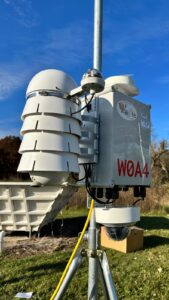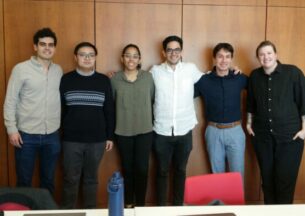From wildfires to bird calls: Sage redefines environmental monitoring
The August 2023 wildfire that devastated Lahaina, Hawaii, was spurred by dry conditions, high temperatures and strong winds. Researchers are monitoring the area to better understand the community’s recovery process and provide new air quality and weather data. This is part of a National Science Foundation project. The team includes researchers from Northwestern University and the University of Hawaii using a specialized artificial intelligence (AI)-enabled sensor designed at the U.S. Department of Energy’s (DOE) Argonne National Laboratory.

The research team has deployed an instrument featuring ten sensors, called a Sage node, near Volcanoes National Park on Hawaii Island. It is part of a multi-hazard monitoring and detection station for natural disasters. The project is in collaboration with University of Hawai‘i at Mānoa professors Jason Leigh, Thomas Giambelluca and Han Tseng. Another node has been installed on Oahu and a third will be deployed in Lahaina on Maui. The nodes will use AI edge devices to process camera images to identify wildfire smoke within seconds. The sensors will also detect smoke in the air and the environmental conditions such as temperature, humidity and wind speed, which are crucial for predicting and monitoring wildfires.
Overall, the project will gather climate and pollutant data to aid clean-up activities in Lahaina and will provide data to guide recovery planning.
Computing at the edge
The Sage project launched in 2019 to create a new kind of national-scale reusable cyberinfrastructure to enable AI at the edge. Sage was led by the Northwestern-Argonne Institute for Science and Engineering (NAISE), a partnership between Northwestern University and Argonne.

Its multi-institutional team is led by Northwestern and includes the University of Chicago, George Mason University, the University of California San Diego, University of Illinois in Chicago, the University of Utah and collaborators at Argonne. Funding is provided by the National Science Foundation.
A Sage node is made up of a combination of sensors, such as cameras and microphones; computing components; and edge applications. Users can attach different sensors to the node based on their specific needs. The nodes are custom-built in the Chicago area. The edge applications interface with the sensors and the connected cloud infrastructure, much like an app on a smartphone. Sensors that capture elements, such as temperature, barometric pressure, humidity, rain accumulation, video and audio, have been affixed to Sage nodes across different projects.
All the components together are about three feet tall, two feet wide and one foot deep, weighing around 30 pounds. They can be attached to a pole or meteorological tower.
The Sage nodes move advanced machine learning algorithms to “the edge.” Edge computing brings data analysis close to where data is collected, making the process faster and more efficient.
Many of today’s distributed sensor systems that include cameras, microphones, and weather and air quality stations can struggle with large volumes of streaming data. These traditional systems often either save data on hard drives that are only accessed a few times a year or send small amounts of data to the cloud for analysis via slow connections. Sage’s AI capabilities at the edge allow for real-time analysis and response from researchers or the system itself.
“The capabilities of machine learning and artificial intelligence at the edge didn’t exist a decade ago,” said Pete Beckman, co-director of NAISE. “Sage opens the door to scientists who will be able to write code that can measure a near limitless number of urban and environmental elements.”
Fast and efficient analysis is best performed by an embedded computer connected directly to the sensor. By linking small, powerful computers (i.e., edge devices) directly to high-resolution cameras, air quality and weather sensors, and experimental Light Detection and Ranging systems, this distributed infrastructure enables researchers to analyze and respond to data almost instantly.
Sage builds on an open-source wireless sensor platform called Waggle. This platform was developed and funded by Argonne in 2013, becoming the lab’s first edge computing project. Functioning as the base platform that projects are built from, Waggle first supported the Array of Things, an urban measurement project that conducted real-time data on the city of Chicago. The Array of Things showed Waggle could be used in urban environments and eventually gave way to the Sage project.
Monitoring wildfires to bird calls
The Sage team has deployed more than 100 nodes across the United States. These sensor networks help understand the impacts of global urbanization, natural disasters and climate change on natural ecosystems and city infrastructure.
Sage’s code, data and hardware are open source, allowing researchers to build their own sensor networks or use Sage’s infrastructure.
Sage software can monitor wildfires, bird sounds, urban traffic and lightning strikes. For example, networking towers in Southern California and AlertWildfire stations in Oregon can analyze camera data for fires and other hazards, even redirecting cameras automatically to areas of interest.
Sage nodes are being deployed to study climate impacts in urban settings as part of the Argonne-led Community Research on Climate and Urban Science (CROCUS) project in Chicago. Another node is located in Wisconsin with the Ojibwe tribe in efforts to help understand wild rice, a food source with important cultural significance. Sage’s AI-enabled sensors give scientists a new tool to understand our planet.
Sage team travel with students to Hawaii

Sage also aims to inspire young people — especially women and underrepresented populations — to pursue science, technology and mathematics careers. Sage provides a platform for students to explore measurement-based science questions related to the natural and built environments.
Undergraduate students from Northwestern University, University of Illinois and the University of Chicago traveled to Hawaii with the Sage team in October 2023 to build and install Sage nodes. The students participated in the instrument’s construction, data gathering, analysis and visualization work.
The students also met with Hawaiian scientists and learned about local customs. They met with Derek Esibill of Windward Community College who is working to restore the traditional ways of aquaculture to sustainably support the growing needs of Hawaii. While there is a Sage node already monitoring air quality and environmental data, the team discussed how remote sensors could help gather data on fish and pond water conditions.
“Their insights helped me understand that computer science can directly help people through collaboration with other scientists and providing better data collection,” said Aldo Malaquias Cabrera, computer science student at the University of Chicago. “I know now that lab work doesn’t have to stay just in the lab but can be used in real-life situations to help people, as long as there’s an understanding between the scientists and communities.”
Anagha Tiwari, a computer science and statistics student at the University of Illinois at Urbana-Champaign, helped install a Sage node near Volcanoes National Park. Armed with hiking equipment and Sage sensor parts, the team mounted it to an 80-foot tower. It took over 10 hours to successfully install.
“It was truly a unique experience and taught me the value of collaboration among scientists and communities to reach goals,” said Tiwari. “I believe that the foundations for such a monumental and successful deployment are the relationships and collaborations Sage developed and nurtured with individuals and organizations in Hawaii.”
The installation includes equipment such as a rain gauge, weather sensors, a particulate matter sensor, a microphone and high-accuracy cameras for both visual and thermal imaging. It will collect data and analytics on air quality, pollution levels, cloud cover, solar irradiance levels and more. The information will be shared with local communities and with the National Park Service to assess the impact of wildfires, volcanic eruptions and biodiversity in the area.
“Sage sensors and edge computing act as vital segways where data collection benefits climate scientists and provides a unique insight into the Hawaiian culture and environment,” said Tiwari. “Through the beauty of teamwork and collaboration, science can be transformed into a catalyst for transformational feedback and change.”
This story was originally published by Argonne National Laboratory













